The Best Sourdough Cinnamon Rolls
This post may contain affiliate links. Please read our disclosure policy.Something magical happens when you add sourdough to cinnamon rolls. I can’t quite put my finger on it, but my goodness, these are the best cinnamon rolls ever. We have a family favorite tried and true cinnamon roll recipe that I’ve been making for years. Think: ooey, gooey, perfectly baked and just incredibly delicious. I took that favorite cinnamon roll recipe and converted it to these amazing fluffy cinnamon rolls and it was a really good idea. Pillowy soft, the perfect amount of gooey cinnamon goodness and a delicious cream cheese icing puts these cinnamon rolls over the top. I hope you love this version for the best sourdough cinnamon rolls. Dare I say it – I think it’s even better than the original recipe.
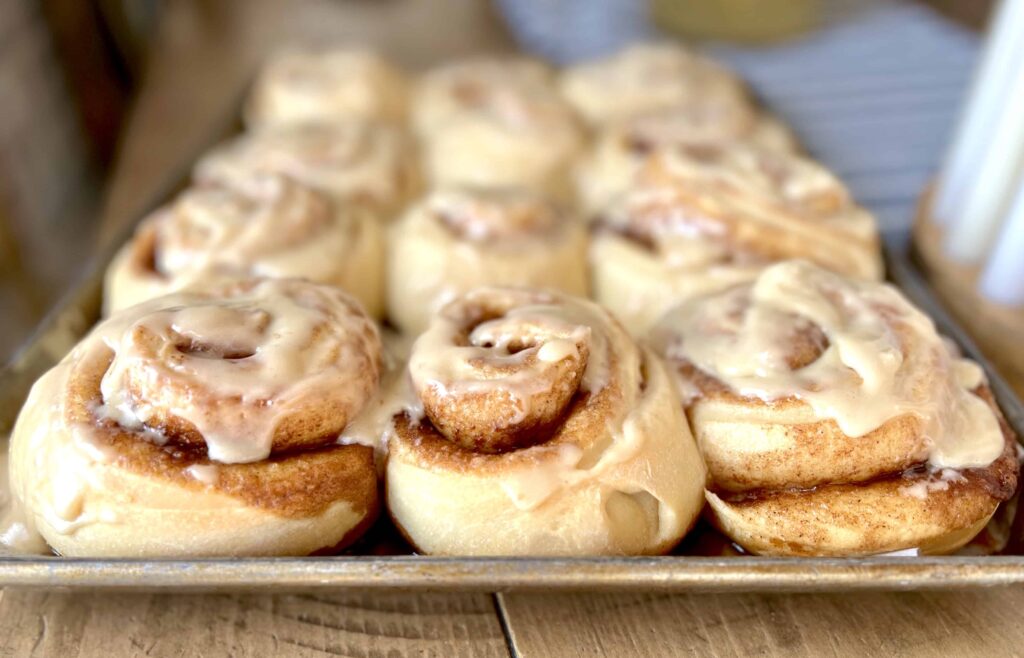
Sample Sourdough Baking Schedule for the Best Sourdough Cinnamon Rolls
A sample baking schedule helps me when baking with sourdough. Sourdough takes much longer to rise than traditional bread. This schedule helps me plan my bake.
A few notes: This schedule assumes the dough temperature is 78 degrees F throughout the process. If you’d like to make the best sourdough cinnamon rolls all on the same day, skip the cold bulk fermentation and go straight to shaping the cinnamon rolls (you will still need to make the levain the night before and let it rise overnight).
| Day 1 | Levain |
| 8 PM -8AM | Make Stiff Sweet Levain. Let rise overnight. |
| Day 2 | Mixing/Bulk Fermentation |
| 8 AM | Mix Dough |
| 8:15 AM | Begin Bulk Fermentation |
| 12:15 PM | End Bulk Fermentation Option 1: Refrigerate the dough for 12-24 hours and shape rolls the next morning Option 2: Shape Rolls and continue with the recipe |
| 12:15 PM – 7:00 AM | Cold Bulk Fermentation |
| Day 3 | Shaping/Baking |
| 7:00 AM | Shape Sourdough Cinnamon Rolls |
| 10:00 AM | Rise in a warm (78 degree F) place for 3-4 hours until puffed up and touching. Do not bake unless dough has puffed up and risen. |
| 10:30 AM | Bake and frost. Serve warm. |
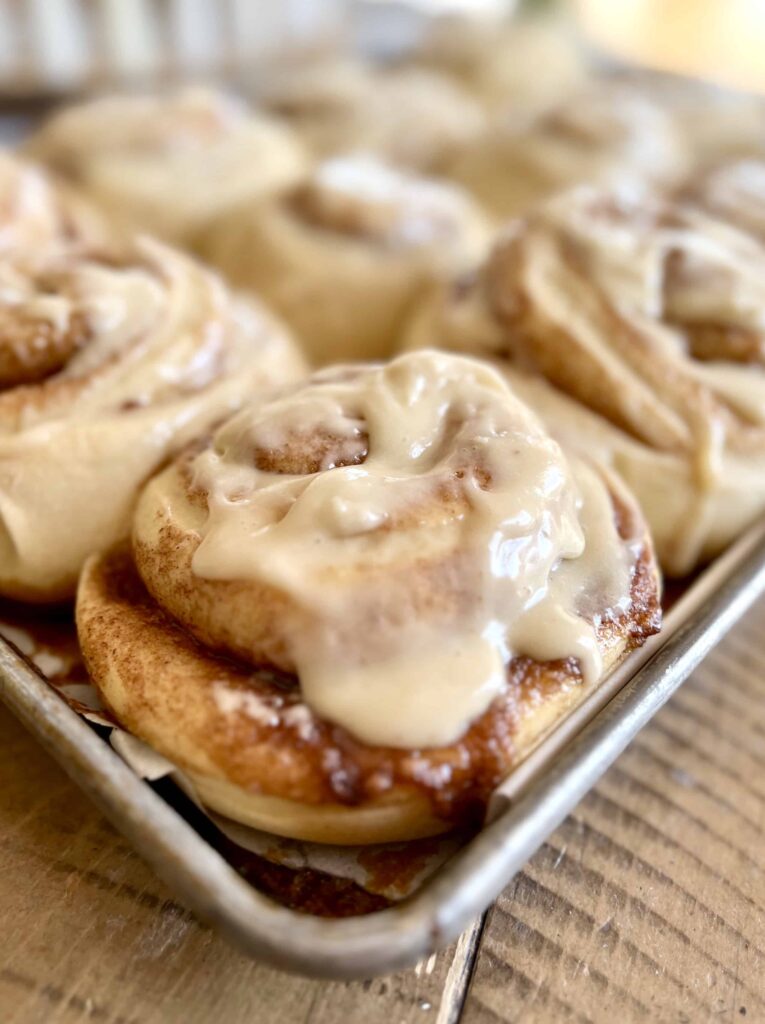
Making a Sweet Stiff Levain
One of the reasons I advocate for making a levain instead of using straight sourdough starter is in cases like these sourdough cinnamon rolls. Maintaining a sourdough starter at 100% hydration makes it easy for me to create a stiff sweet levain when I need it for an enriched dough. I also use a stiff sweet levain for enriched breads like this cinnamon sugar babka. A stiff levain is a levain that mixes up to a firm consistency and is anywhere from 50%-65% hydration. It adds elasticity to dough and helps temper the acid in the sourdough, which gives all the benefit of sourdough fermentation without the tang. The sugar in the levain helps counteract the acidity and creates a more mild flavor. My sometimes picky kids are especially grateful for this! To make a stiff sweet levain:
- Use 100% hydration sourdough starter at its peak
- Add 20 grams of ripe sourdough starter to 100 grams of all purpose flour, 50 grams of water and 20 grams of sugar. Mix together.
- A stiff levain will be a little more difficult to mix together, because it forms a dough ball instead of a batter. Knead the ball of dough a few times until smooth.
- Place the stiff sweet levain in a liquid measuring cup and set in a warm (76-78 degree F) spot for 12 hours.
- Stiff Sweet Levain is ready to use when it has doubled in size and has a rounded top. Using it right when it reaches its peak will help decrease the acidity in the dough.
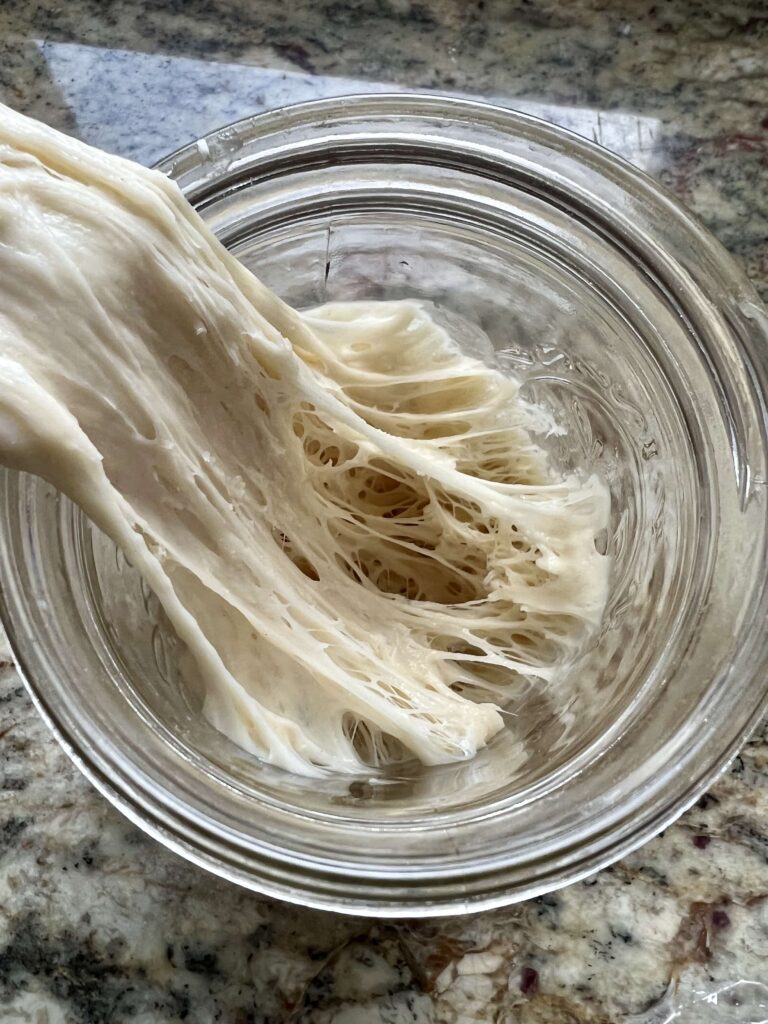
Mixing the Dough
I use a Bosch mixer or KitchenAid mixer to mix this dough. If you don’t have a stand mixer, you can use your hands, though it will take longer. Add all the dough ingredients to the mixer and fit it with a dough hook. Reserve a little bit of the flour to add toward the end of mixing the dough as needed. Weight measurements are always more accurate than volume, but I always like to reserve a bit of flour (about a half cup) so I don’t over-flour my dough. Varieties of flour and weight of eggs can impact the amount of flour added to dough, so I play it safe. It’s easier to add more flour than to fix over-floured dough. Mix the dough on low speed for about 3-5 minutes. Add the reserved flour as needed. The dough should be tacky, not overly sticky. Continue kneading about 5 more minutes until smooth, elastic and it passes the windowpane test. Place in a container or bowl for bulk fermentation.
Bulk Fermentation
Bulk fermentation is the name for when the dough ferments in one big mass. Put the dough in a container and cover it. The entire bulk fermentation should take about 4 hours at 78-80ºF. Take the temperature of the dough, it should be between 78-80ºF. If your dough is significantly colder, bulk fermentation will take longer. If it’s warmer, the bulk fermentation will be a bit shorter, however wild yeast perform best in the 76-78 degree F range, so do your best to keep the dough in that range. I use a dough proofer or the inside of my oven with the light turned on (don’t turn the oven on!) to keep my dough warm. Let the dough sit for 4 hours in that warm place. By the end of 4 hours it should have puffed up and risen a bit.
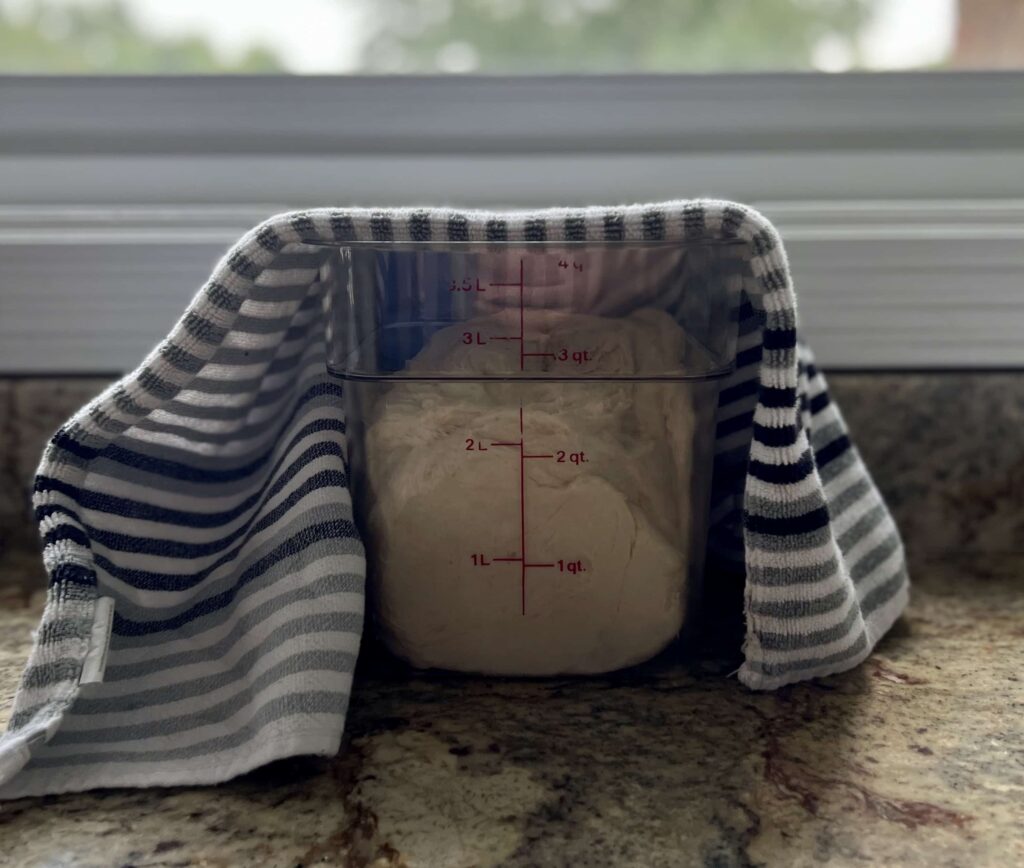
Cold Bulk Fermentation
After the initial 4 hour bulk fermentation is finished, my favorite way to make these rolls is to put the covered container in the refrigerator overnight. This allows me to shape the rolls the following morning and we can enjoy some of the best sourdough cinnamon rolls to start the day. I also think this step improves the flavor of the cinnamon rolls. If you want to make them all in the same day, that works too. Just skip the cold bulk fermentation and proceed with the rest of the recipe (you will still need to make the levain the night before and let it rise overnight). The cinnamon roll dough can stay in the refrigerator for 24-48 hours before using. When you’re ready to shape the cinnamon rolls, pull the dough out of the refrigerator and let sit at room temperature for a few minutes while you prepare the cinnamon roll filling and the baking sheet.
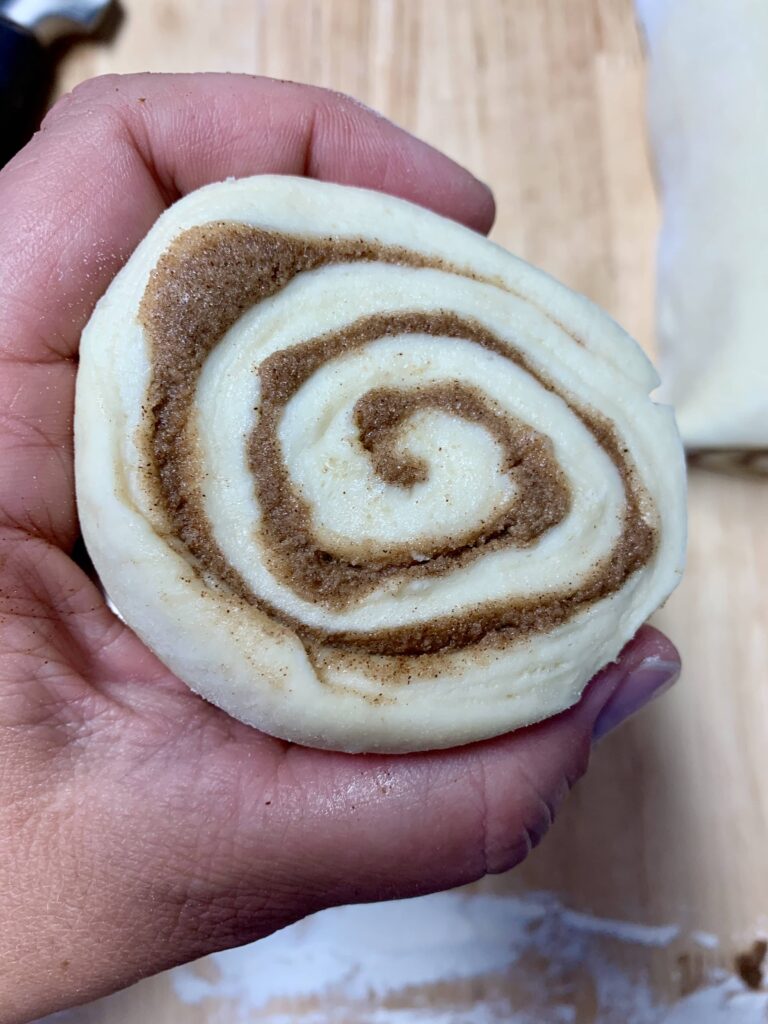
Cinnamon Roll Filling
Throughout the many years of making cinnamon rolls, I’ve learned a few tips that have upped my cinnamon roll game. Many cinnamon roll recipes will have you spread butter over the dough and then add the cinnamon sugar mixture on top. Instead, I like to mix together soft/melty butter in a bowl and mix cinnamon, brown sugar and a little bit of flour into the butter. Then I spread the cinnamon-sugar paste over the roll dough. I think this gives a more even flavor, and that little extra flour helps keeps the rolls from gaping open when baked. If you want to add nuts or raisins into your rolls, you can add them right on top of the cinnamon-sugar paste and roll them right up. For pecan lovers, I’ll add some toasted pecans on top of the baked rolls.
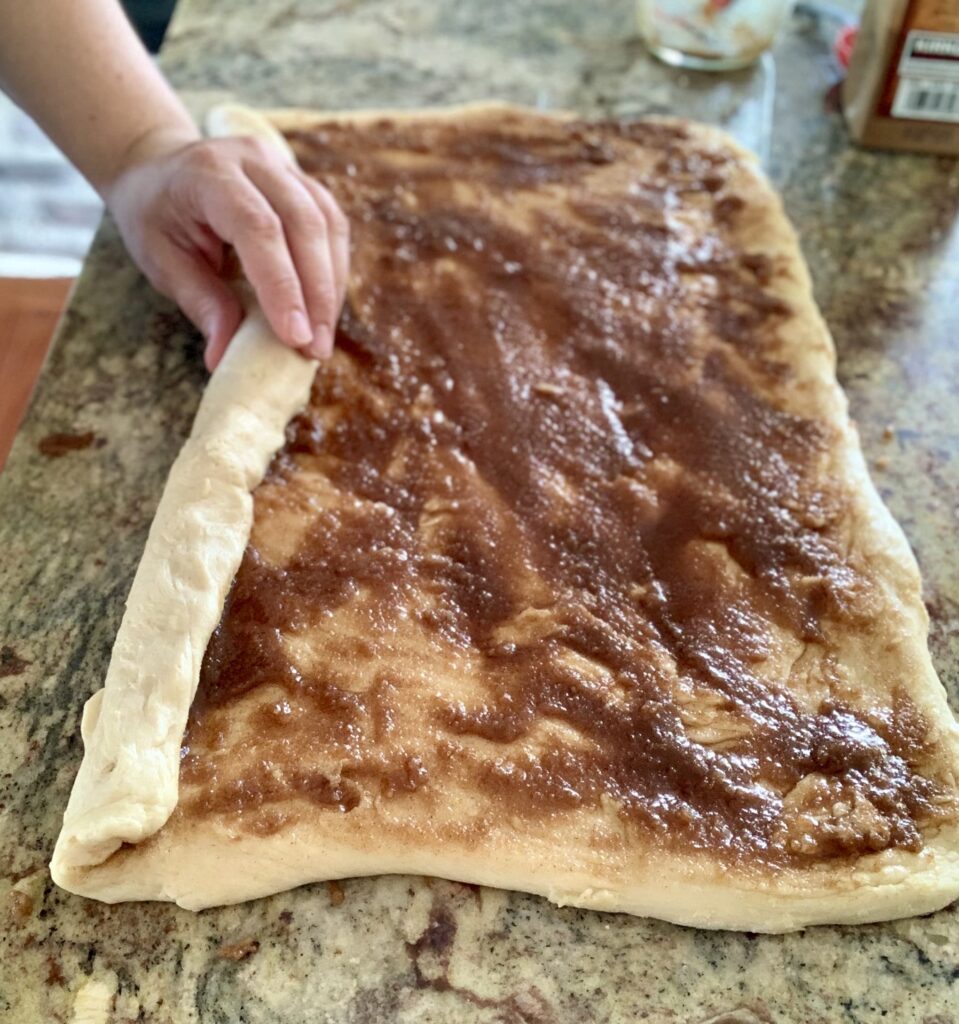
Shaping the Best Sourdough Cinnamon Rolls
This recipe makes 12 large cinnamon rolls or 24 regular-sized cinnamon rolls. Roll the dough out on a lightly floured countertop or pastry mat about 20 inches by 10 inches. Spread on the filling and then roll up, pinching the seam together. To cut out the cinnamon rolls, you can use a sharp knife, bench cutter or even dental floss. Cut the log in half and then cut six equal-sized rolls from each half. Place the rolls on a parchment-lined baking sheet. If you have any wispy cinnamon roll ends, go ahead and tuck them under the roll so they don’t come loose during the bake.
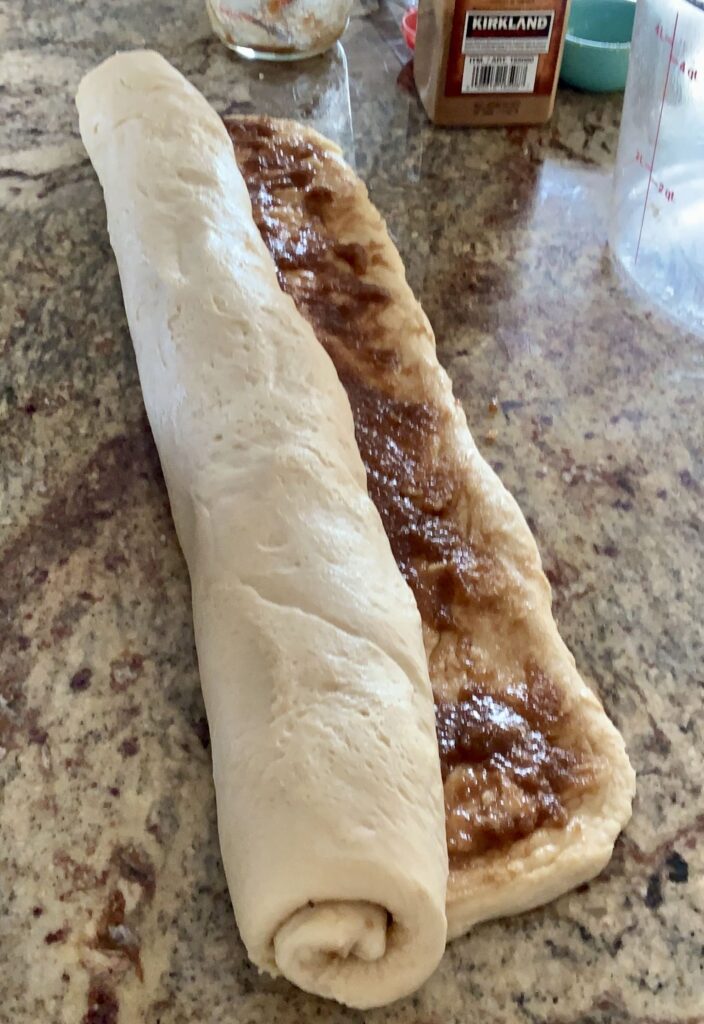
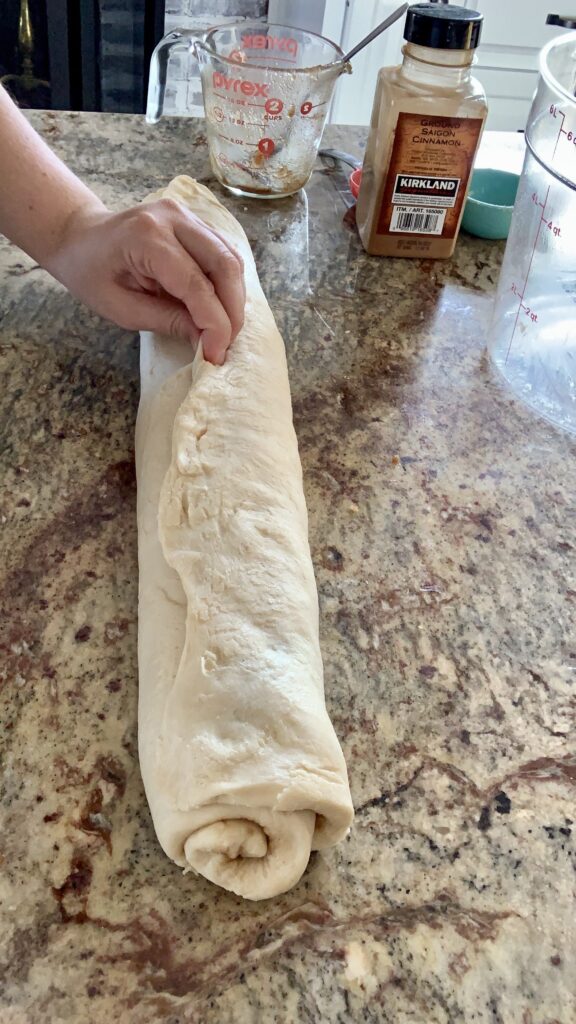
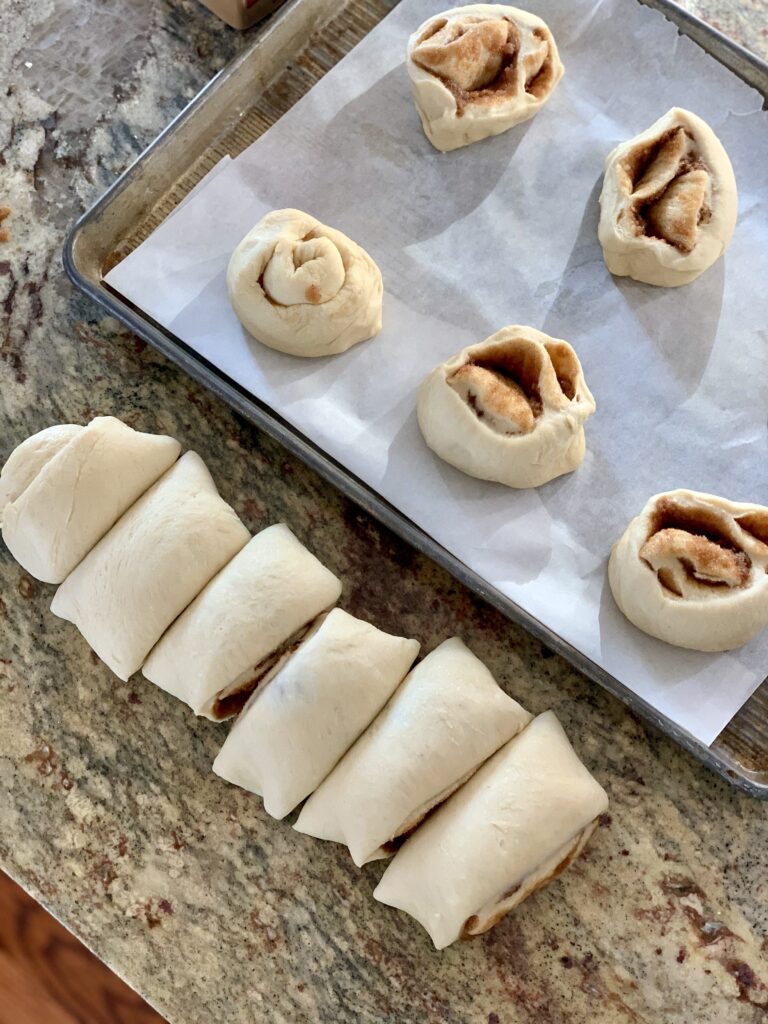
Proofing Sourdough Cinnamon Rolls
The best sourdough cinnamon rolls need more time to rise than traditional cinnamon rolls thanks to the sourdough. They also require a warm environment to rise–right around 80-85ºF. Make sure that you put your pan of shaped rolls in a warm spot. I often use the oven with the light turned on. Let the rolls rise and get puffed up. Lightly touch the rolls and they will feel soft and airy. If they feel dense–do not bake them yet! Let them rise. This final rise is a very important step in the process. Take a finger and gently press into the side of the roll. If it springs back right away, you need to let the dough rise longer. If it stays indented with just a little bit of spring, they are ready to bake.
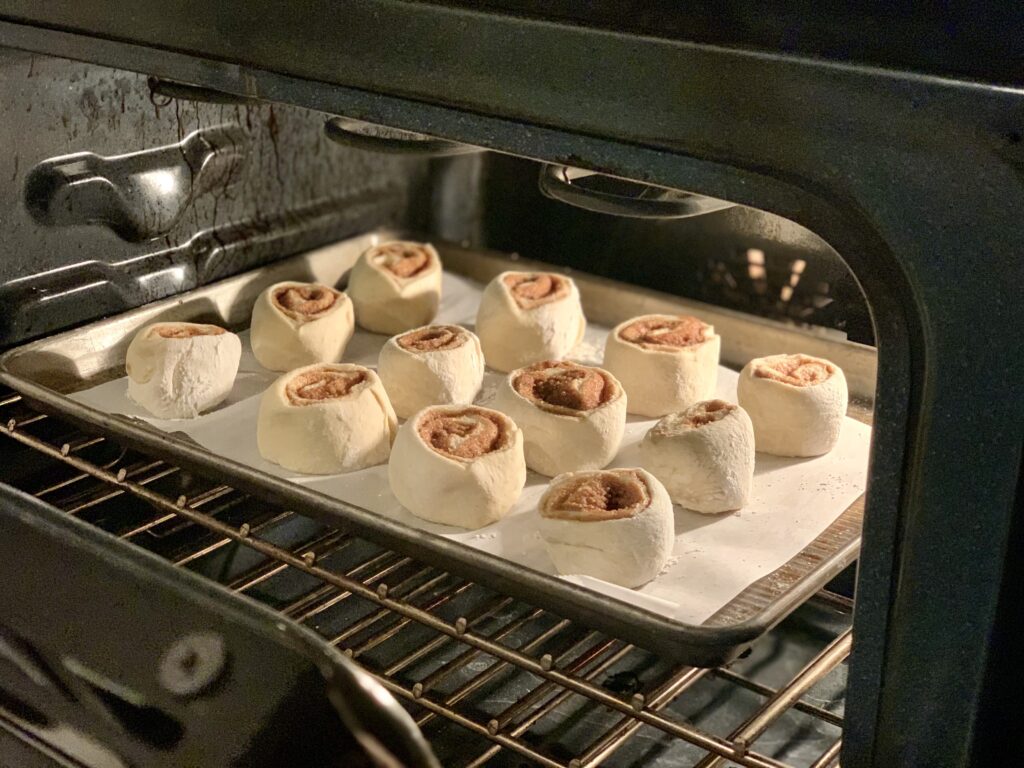
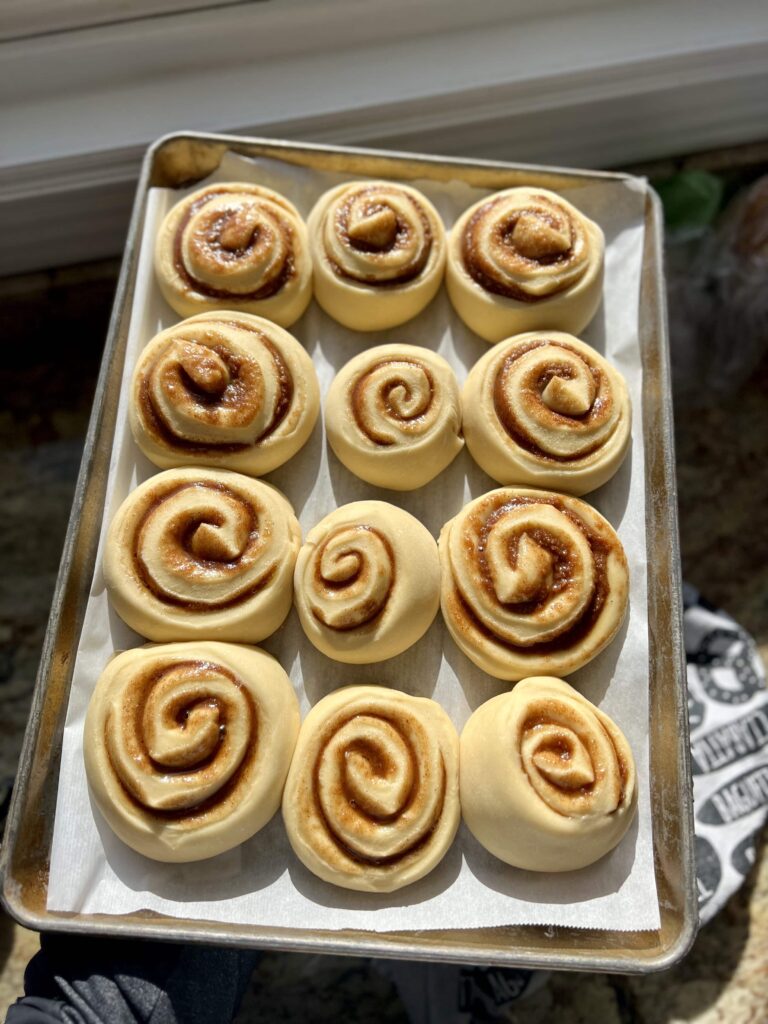
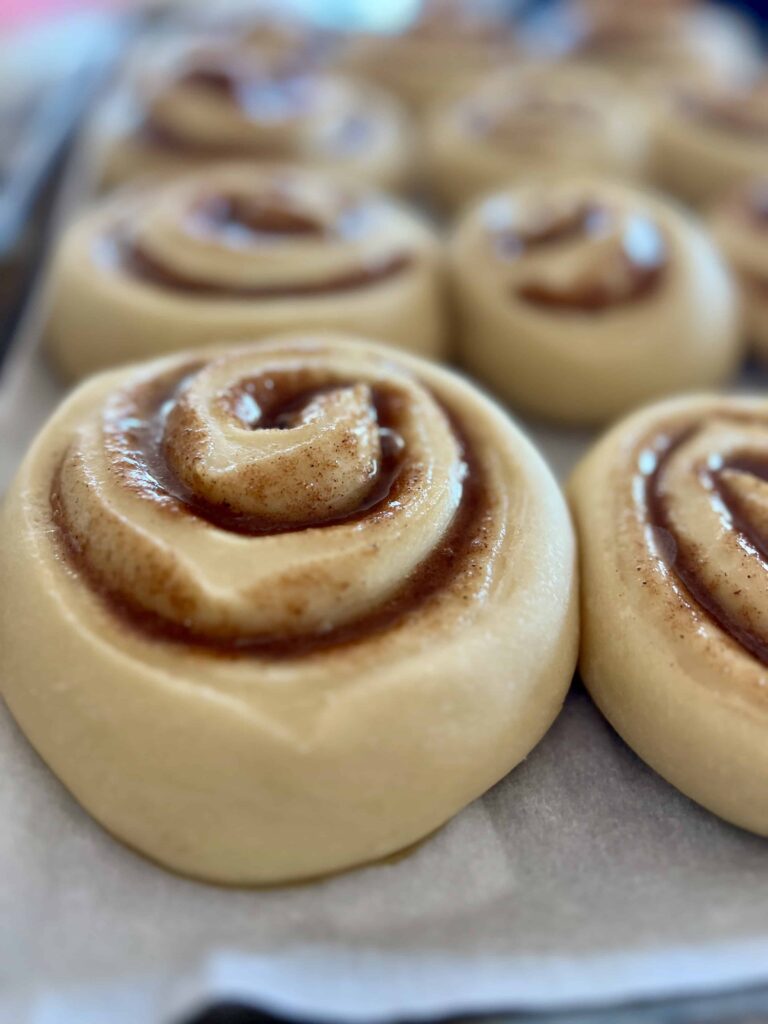
Baking Sourdough Cinnamon Rolls
Preheat your oven to 350ºF (make sure you take the risen cinnamon rolls out if you are using your oven as a proofing box). Bake the rolls for about 20-25 minutes. Ovens all bake differently. Some ovens bake hotter in the back and cooler in the front. If you want an even bake on your rolls, rotate your pan 180º after the first ten minutes of baking. This will keep half of your rolls from getting too dark or the other half being too light. Check the center of one of the cinnamon rolls after baking to make sure that the middle isn’t raw. Sometimes you need to let them go a minute or two longer to make sure they are completely baked through.
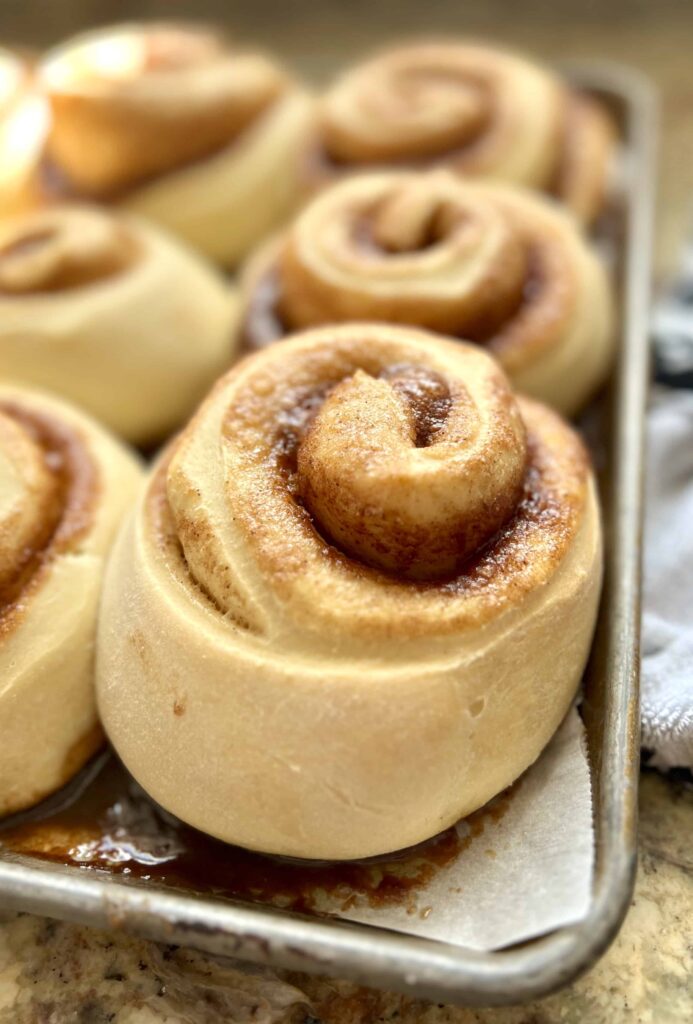
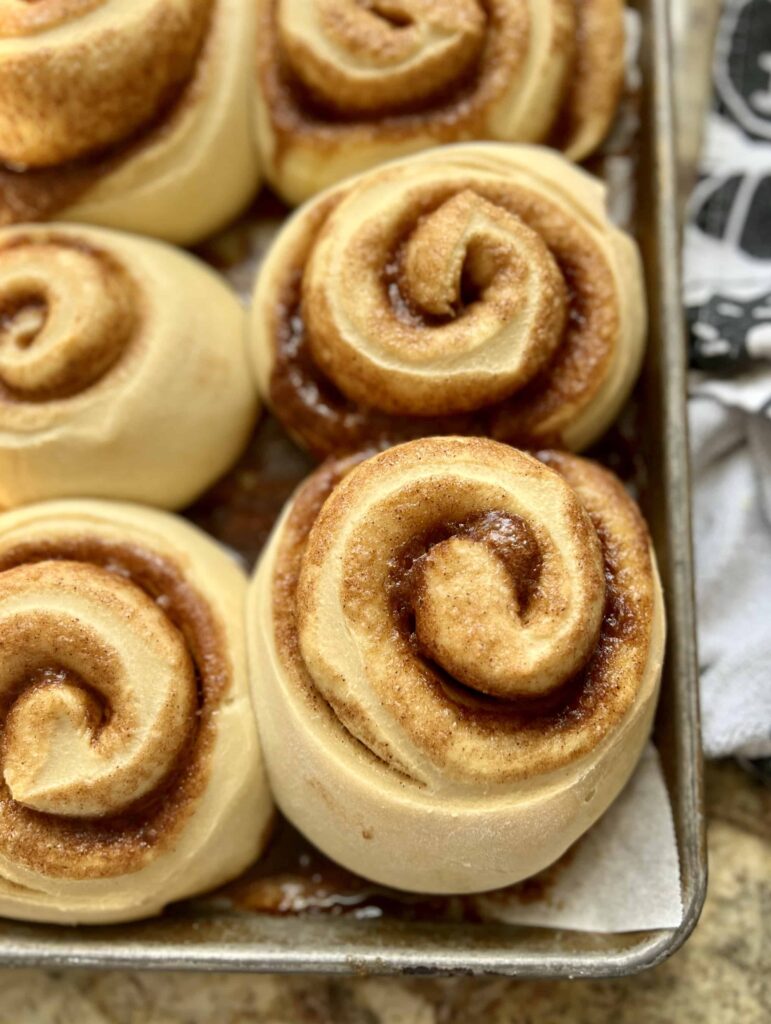
The Best Cinnamon Roll Frosting
The frosting on these rolls is amazing. There’s no other way to describe it. I’m not a huge fan of overly “cream cheesey” tasting frosting, and the ratios on this icing are just perfection. More butter than cream cheese, when all whipped together the frosting takes these rolls to an ethereal level. I also highly recommend adding in the maple flavoring that really gives a unique taste to the entire cinnamon roll. It is just divine! Whip the frosting until it is thick and creamy. Let the cinnamon rolls cool about 5 minutes before spreading a large dollop on each roll.
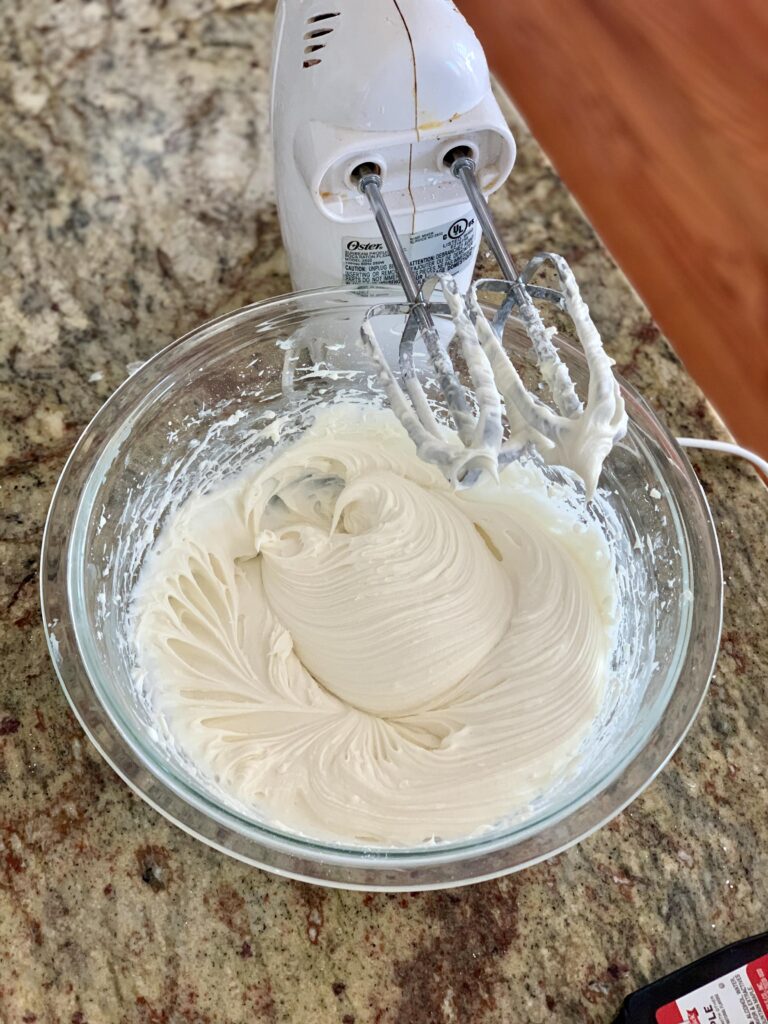
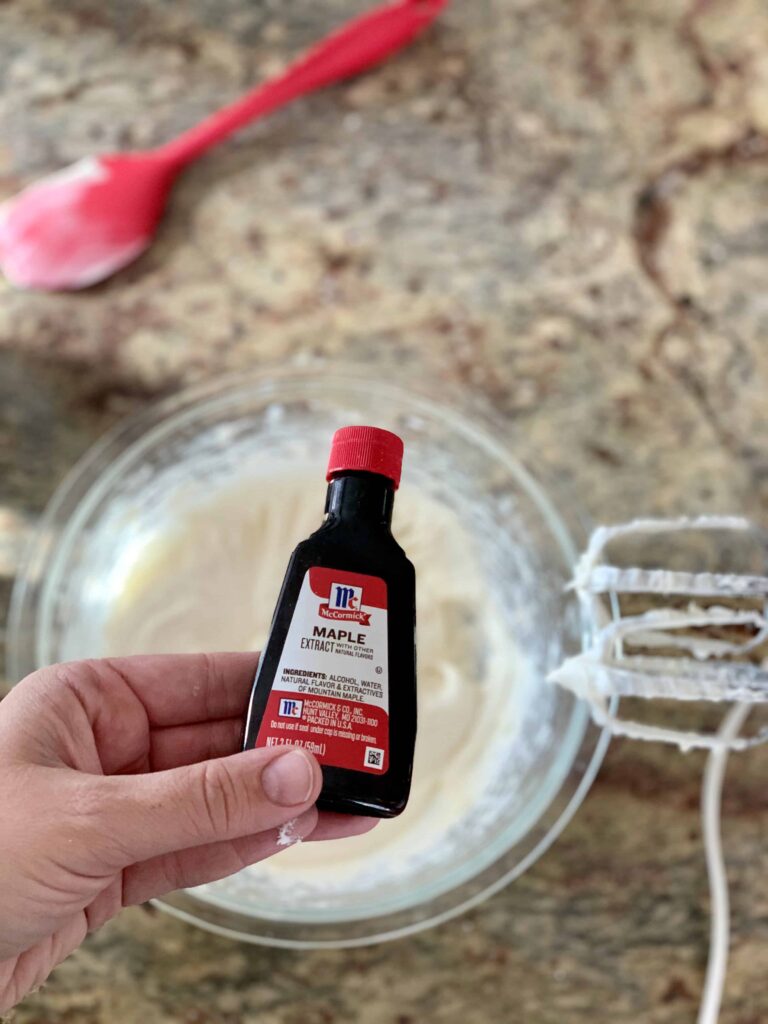
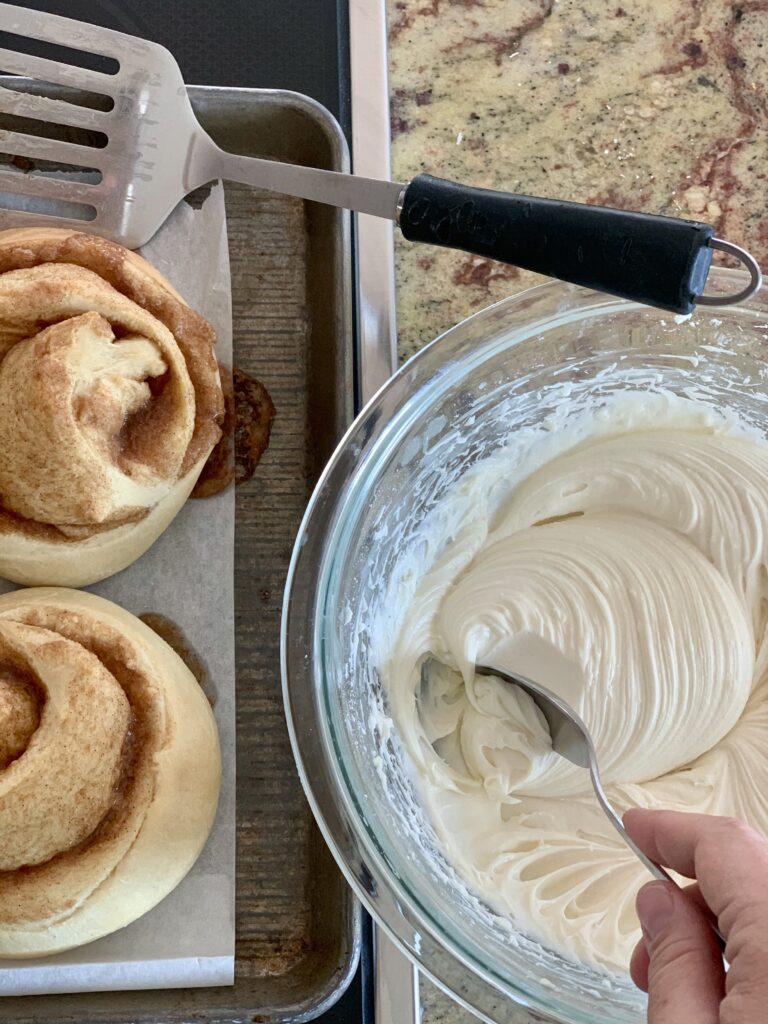
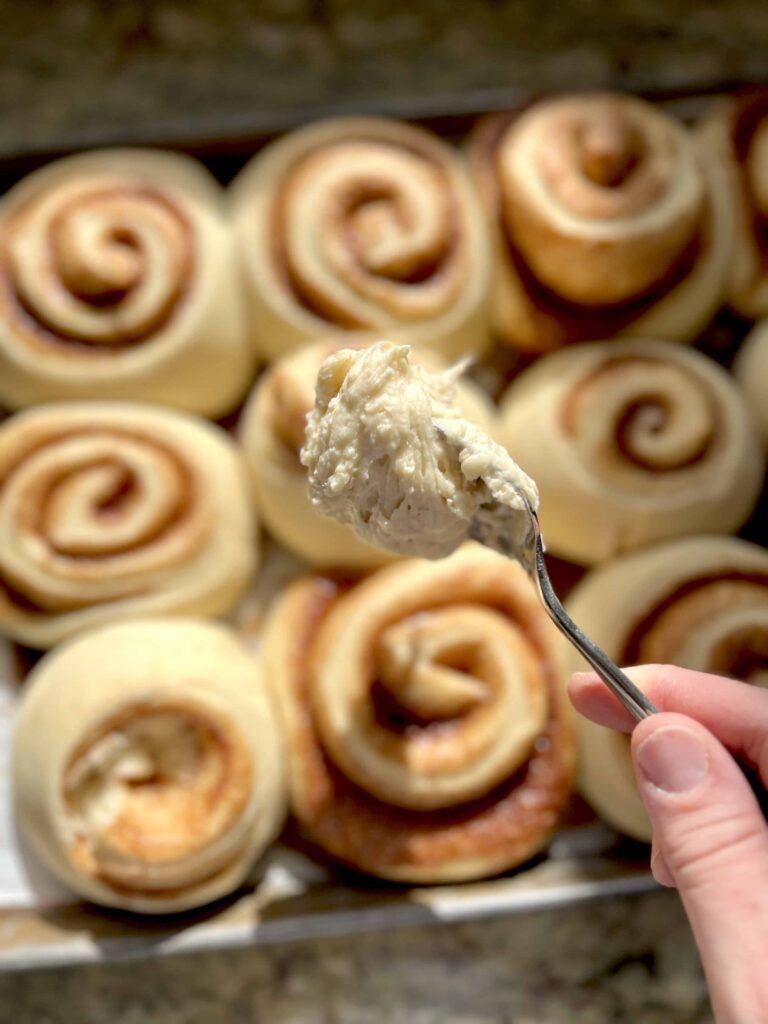
Have I convinced you yet? You need these cinnamon rolls in your life, and your family does too. I love the sourdough version so much that I don’t even feel guilty about feeding this decadent treat to my family because: sourdough!
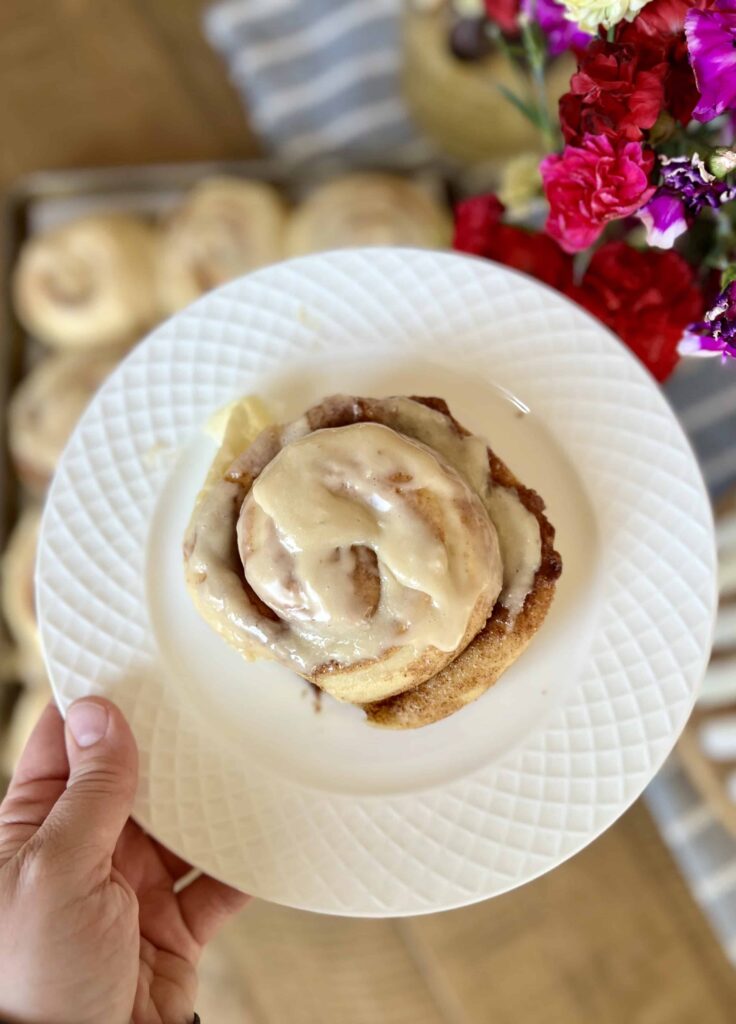
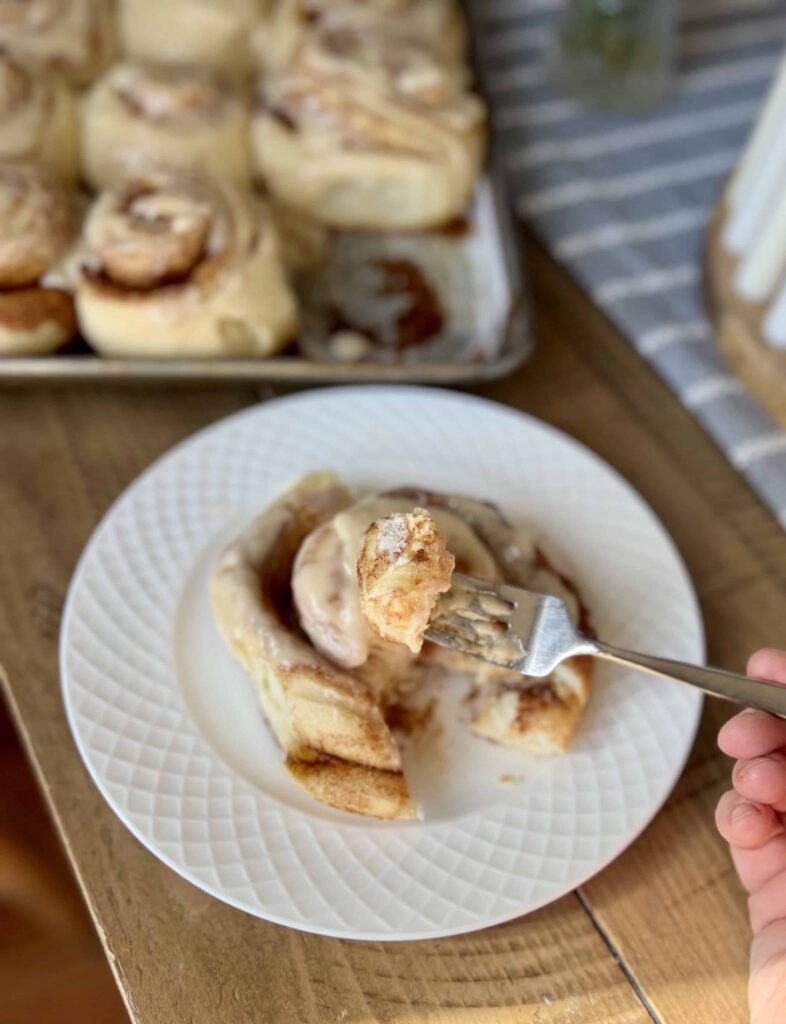
Frequently Asked Questions
I’ve experimented with a couple different options. I found that when the rolls are touching, they need a little bit longer to bake through completely. These are some examples of pans I’ve used for cinnamon rolls:
Pie Pan (7-8 inch): You will need 2 pans, 4 rolls to a pan and bake for about 30-35 minutes.
Pie Pan (10 inch): One dish will fit all 8 rolls snuggly. If you like the look of rolls all baked together, use a large circular pie pan. Bake 45-50 minutes.
Glass Baking Dish (9 by 13): Bake for about 30-35 minutes
Half Sheet Pan: Rolls will not be touching. Bake for 20-25 minutes.
Place any leftover cinnamon rolls in a ziplock bag and store them in the freezer. When you want one, take one out of the freezer and warm up in the microwave for 30 seconds to a minute and enjoy.
Make sure you use your starter and levain when they are ripe and active. Temperature also has a large impact on how long it takes for sourdough to rise. Keep your rolls warm during the proofing process, 80-85ºF should get them rising well.
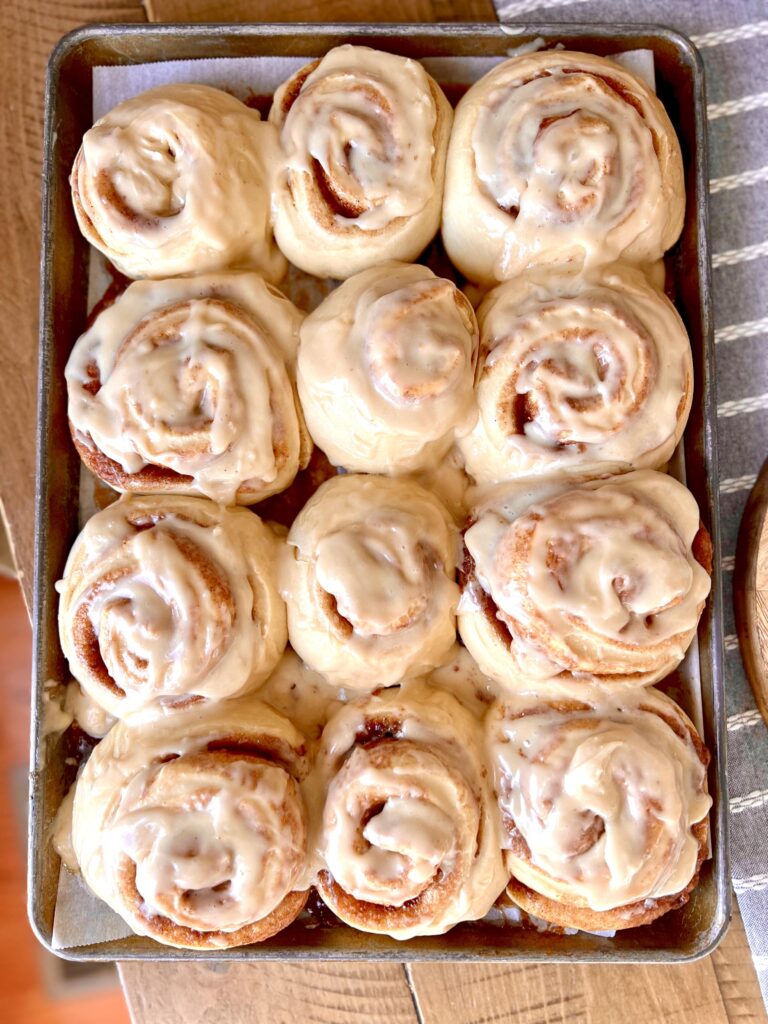
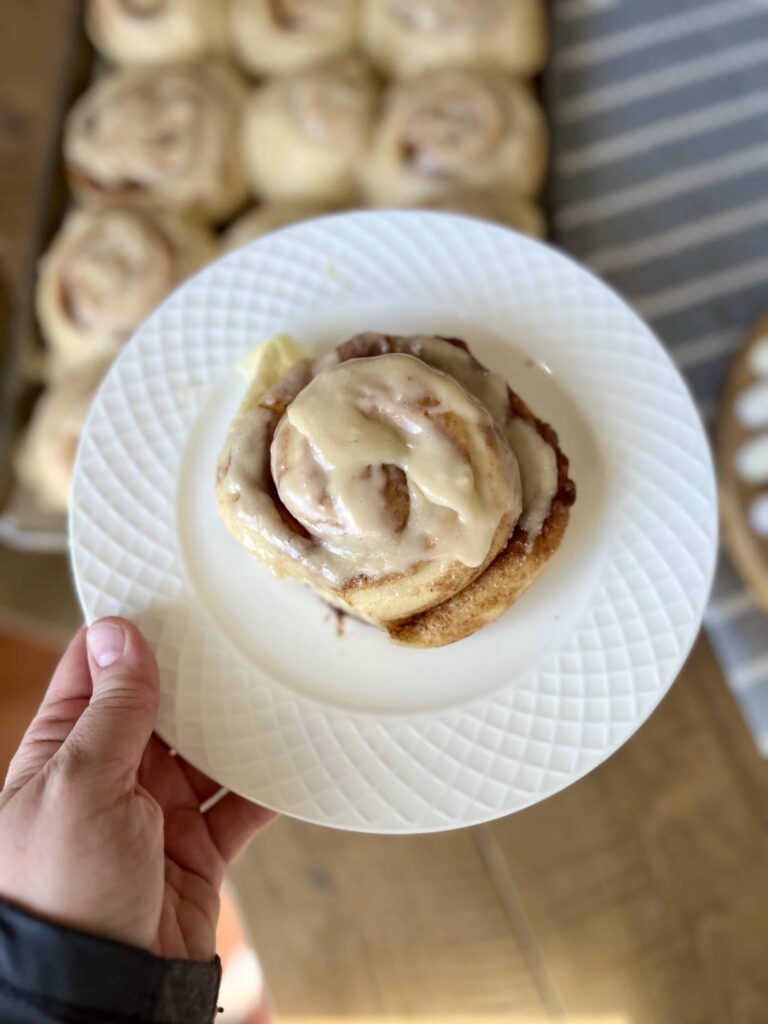
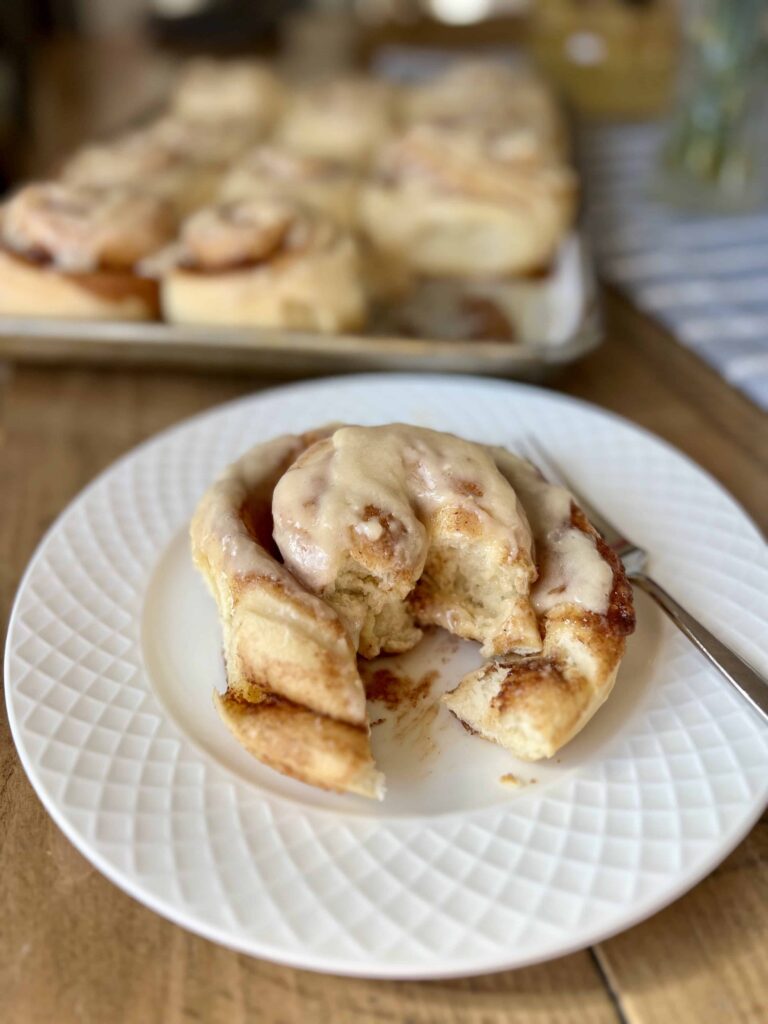
If you loved these sourdough cinnamon rolls, you’ll also love…
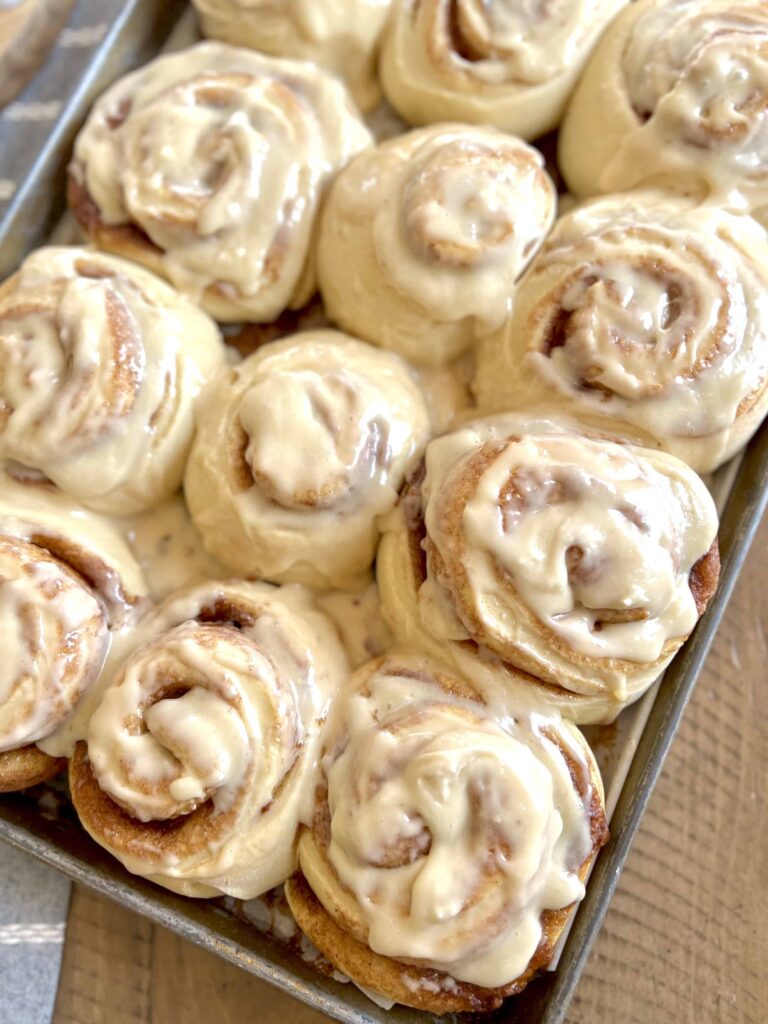
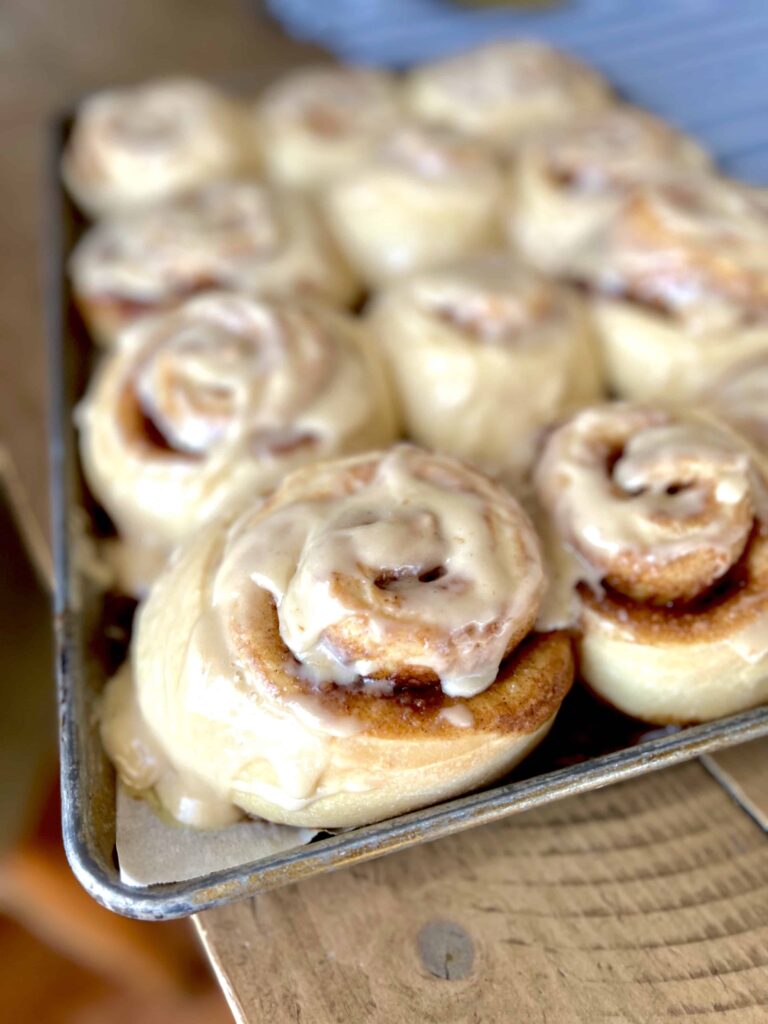
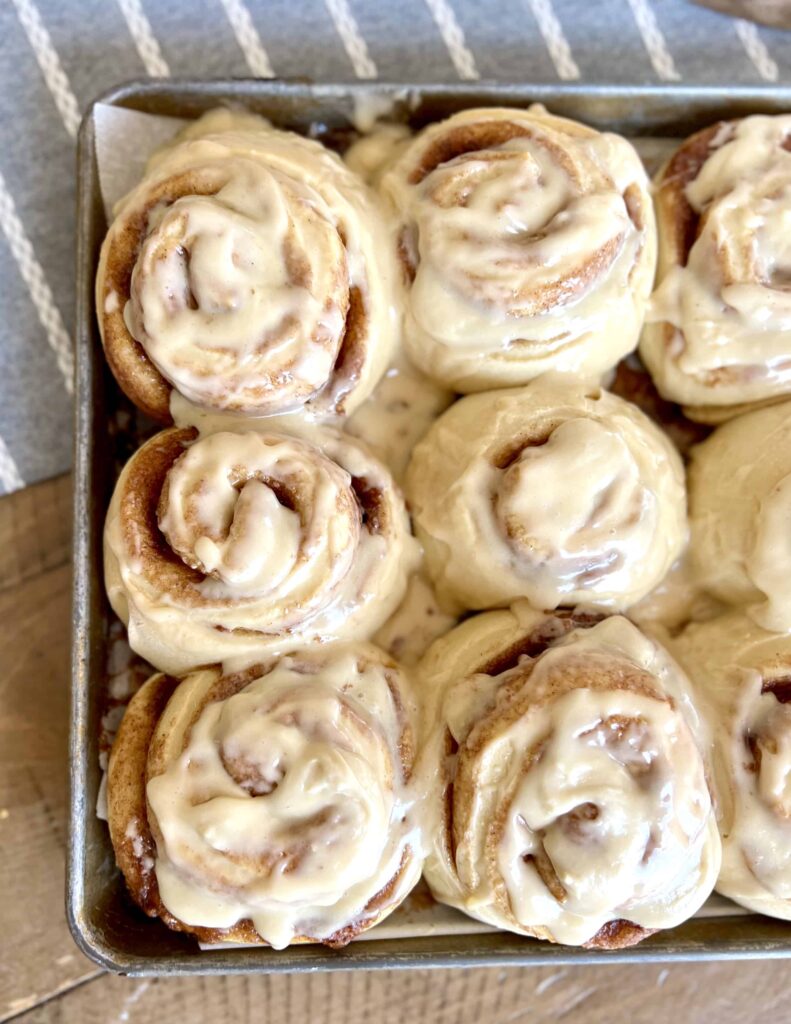

The Best Sourdough Cinnamon Rolls
Ingredients
Sweet Stiff Levain (10-12 hours/overnight at 78ºF)
- 20 grams sourdough starter
- 20 grams granulated sugar
- 100 grams all purpose flour
- 50 grams water
Sourdough Cinnamon Rolls
- 180 grams levain
- 440 grams warm whole milk about 1 3/4 cup, see recipe notes
- 113 grams unsalted butter, melted about 1/2 cup
- 115 grams granulated sugar about 1/2 cup
- 2 large eggs about 100 grams total
- 12 grams salt about 1 1/2 teaspoons
- 950 grams bread flour about 6-7 cups
Cinnamon Roll Filling
- 113 grams unsalted butter very soft or melted, 1/2 cup
- 200 grams packed brown sugar about 1 cup
- 8 grams ground cinnamon about 1 Tablespoon
- 10 grams all purpose flour about 1 Tablespoon
Cinnamon Roll Frosting
- 113 grams unsalted butter softened, 1/2 cup
- 57 grams cream cheese softened, 1/4 cup
- 250 grams powdered sugar about 2 cups
- 30 grams heavy cream about 2 Tablespoons
- 5 grams vanilla extract about 1 teaspoon
- 2 grams maple extract about 1/2 teaspoon
- pinch of salt to taste
Instructions
Levain (12 hours, overnight)
- Mix together ripe sourdough starter, all purpose flour, granulated sugar and water. Knead the levain until it forms a cohesive ball. Set in a liquid measuring cup and cover for 10-12 hours until the levain has doubled in size and the top is rounded.
Sourdough Cinnamon Rolls
- Warm the milk in the microwave (about 1 1/2 minutes full power) or on the stove. It should be around 90-100 degrees F, no warmer than that. To the bowl of a stand mixer with a dough hook, add the ripe levain, warmed milk and melted butter.
- Add the sugar, eggs, salt and most of the bread flour. Turn on the dough hook and knead for a few minutes. Add the remainder of the bread flour as needed. The dough should be tacky, not overly sticky and should all cling to one side of the bowl (or away from the edges depending on your mixer). Knead for a total of 8-10 minutes until the dough is smooth.
- At the end of about 4 hours, the dough should be puffed up and feel very elastic. If it doesn't feel this way, let it bulk ferment for another half hour and check again.
- Overnight Refrigeration: At this point, after the bulk fermentation has finished, cover the dough and put it in the refrigerator. Proceed with the recipe the next day, shaping and proofing the rolls before baking. This allows you to time the cinnamon rolls for breakfast or brunch if desired. If you prefer to shape the rolls and bake them the same day, skip the overnight refrigeration and proceed with the recipe.
- Mix up the Filling: Near the end of bulk fermentation, mix up the cinnamon roll filling. To a small bowl, add the melted butter, brown sugar, cinnamon and flour. Mix together. Set aside.
- Shaping: Line a half sheet pan (18 by 13 inches) with parchment paper. Roll the dough out into an approximate 18 by 12 rectangle. Spread the cinnamon filling all over the dough with your fingers, making sure to cover up to the edges of the cinnamon roll. Starting with the dough closest to you, roll up the cinnamon roll and pinch together the seam. Flip the cinnamon roll over, seam side down. Cut the long log of cinnamon roll dough into 12 equal pieces. Place the cinnamon rolls on the parchment paper, snuggling all 12 rolls together on the pan.
- Proofing: Cover the pan and let rise in an 80-85ºF place until puffed up and risen, about 3-4 hours. Do not bake these rolls if they have not risen.
- Baking: Pre-heat the oven to 350º F. Bake for about 22-25 minutes until baked all the way through.
- Cream Cheese Frosting: Using a hand mixer, whip together softened butter and cream cheese. Add the powdered sugar, heavy whipping cream, vanilla extract, maple extract and salt. Whip together for 2-3 minutes, scraping down the sides of the bowl as needed. The frosting should be light and fluffy.
- Spread frosting over the tops of the cinnamon rolls while they are still warm. Enjoy!

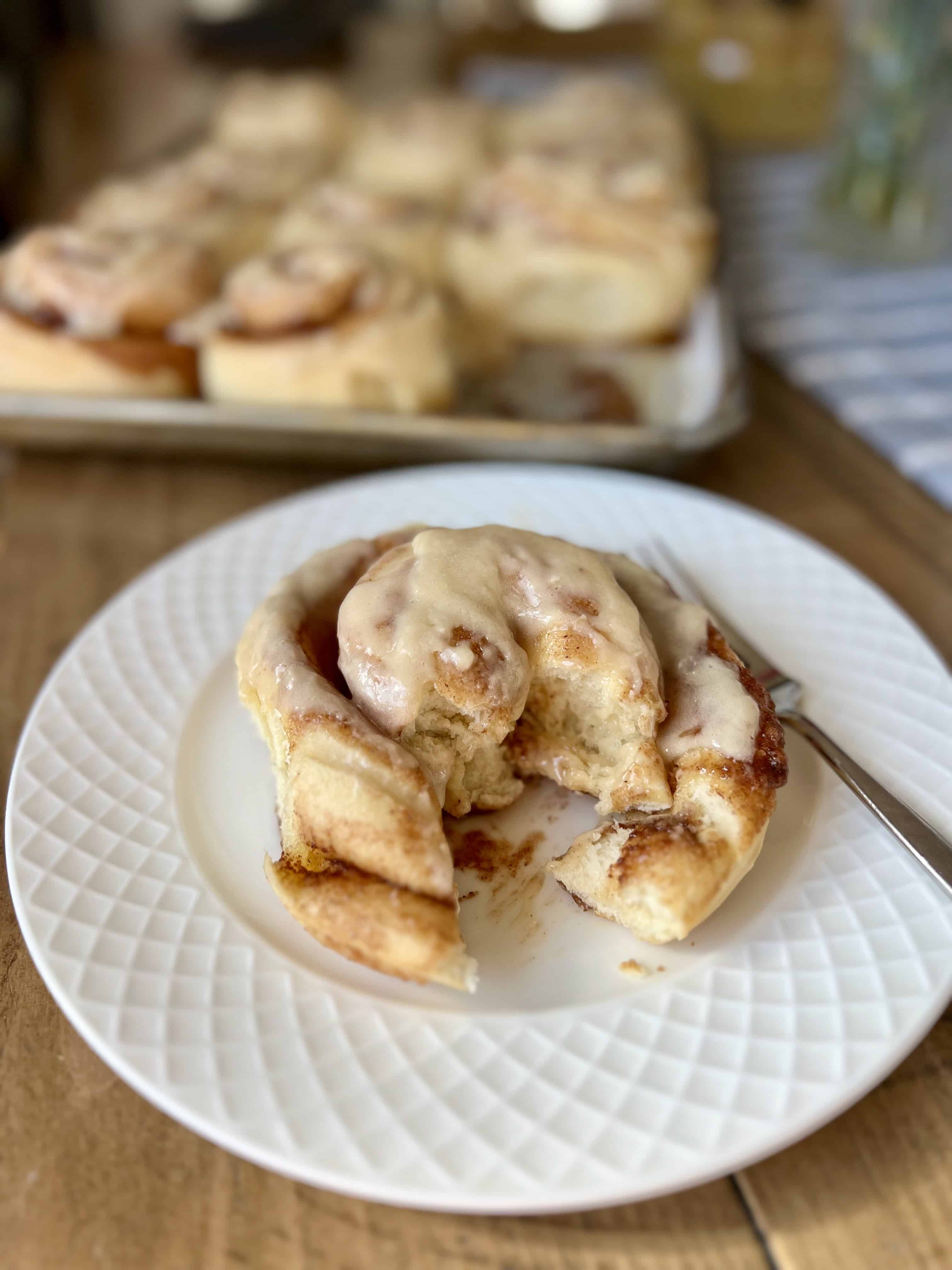
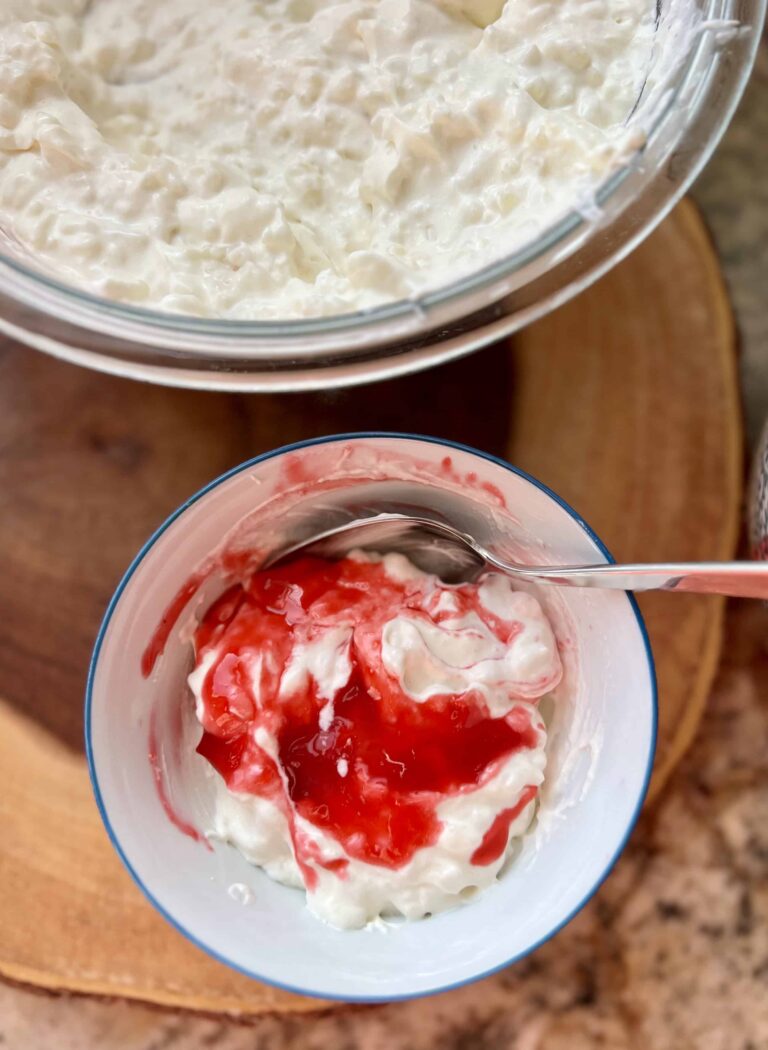
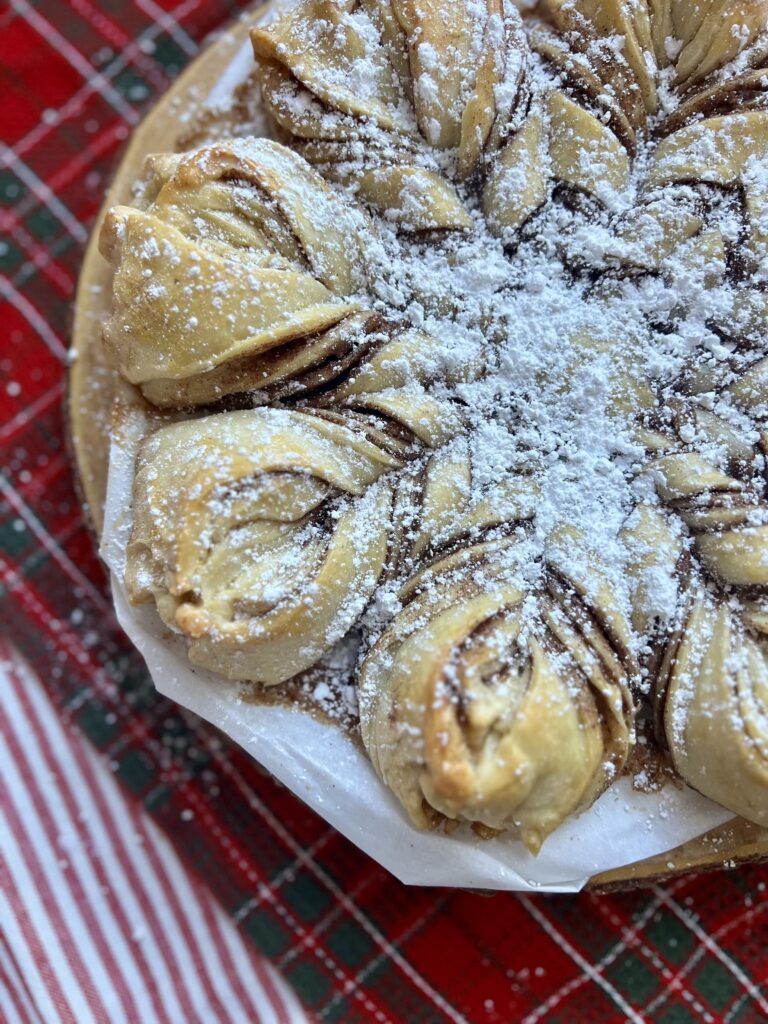
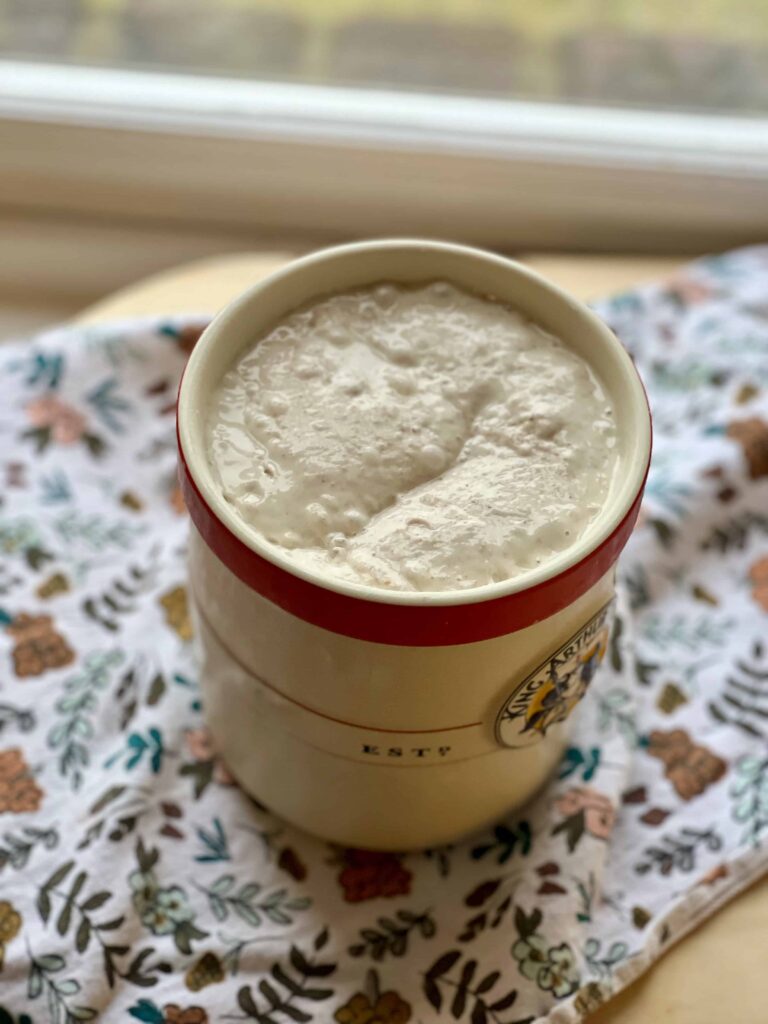
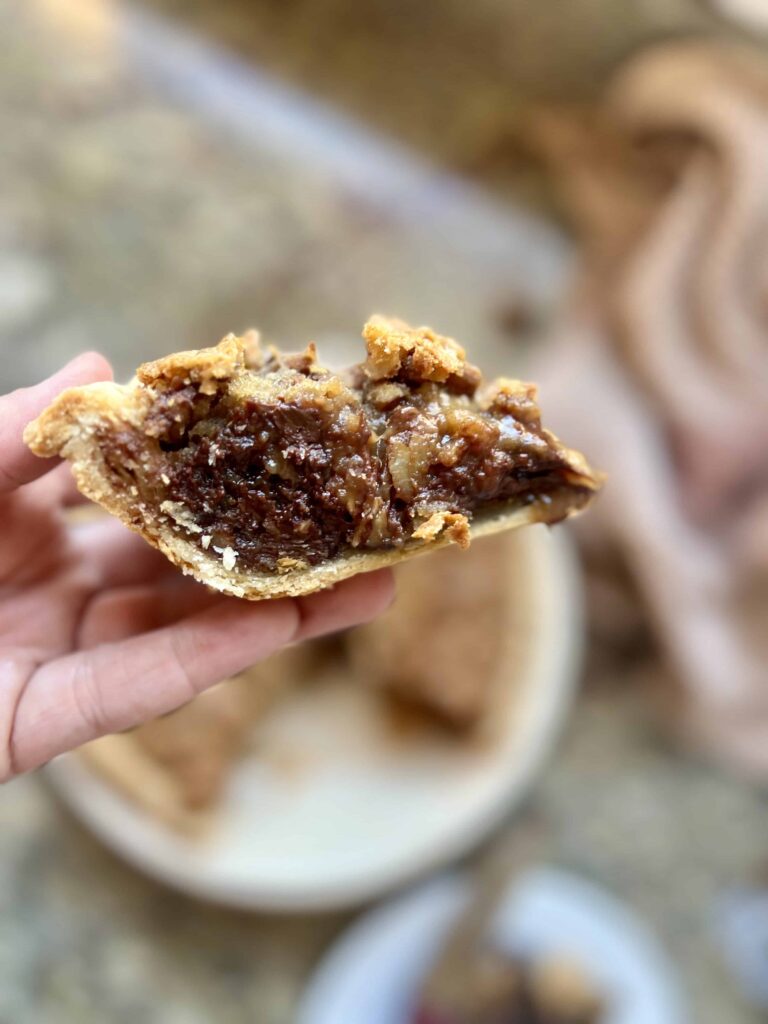
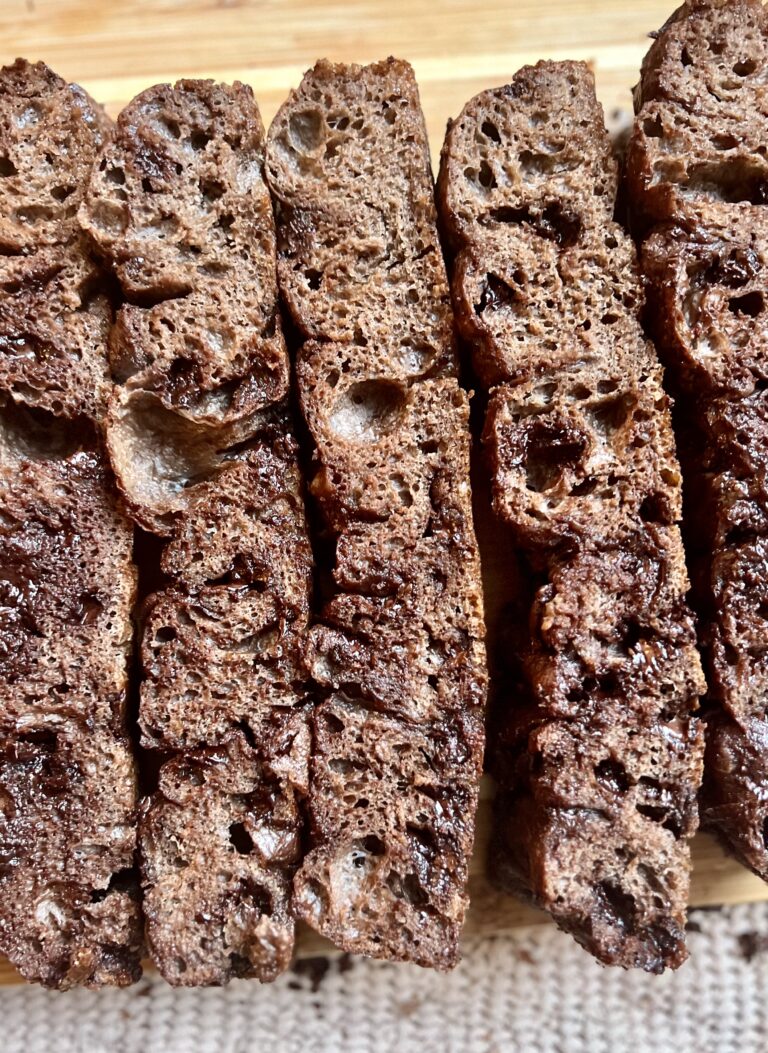
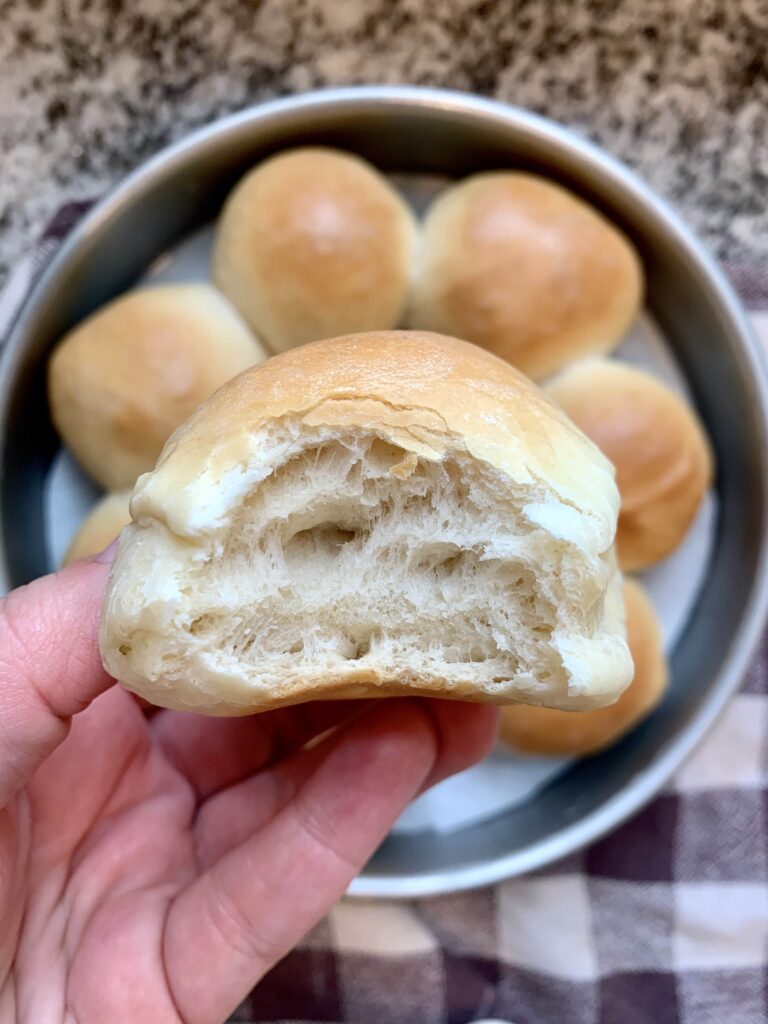
Could I use ghee instead of butter for the dough
I haven’t tried that but I think it would work.
I made these to take to my SILs house for coffee at the end of last year. The flavour is delicious 😋
I may have underbaked them though, as the middle row was a bit too gooey. Next time I will split them between 2 trays. Will make again 👏
Thanks for sharing!
How can you tell if they are done all the way through? Do you use a toothpick like cake?
I usually tap the center of the largest cinnamon roll of the bunch to see if it’s baked through. Sometimes I’ll pull the pan out and gently up the center of one of the cinnamon rolls (when it’s covered with frosting no one can tell) and see if it’s still doughy or baked through.
These are delicious. Also great as orange rolls. Gave some to a friend and he said “These are the best rolls that I have ever had.” Thanks for sharing! We are addicted!!
So glad you enjoyed them! Thanks for the review.
I’m questioning the salt amount. 12g is a lot. And definitely more than 1.5 tsps. I measured 3 times and the math wasn’t mathing.
Scales with very small measurements can sometimes be inaccurate. One teaspoon of salt weighs about 5-6 grams, so 12 grams is about 1 1/2 -2 teaspoons. My weight measurements are how I measure and bake the recipes, so they are going to be very accurate. The cup measurements are less accurate because people measure volume differently (1 cup of flour is different depending on who is measuring it).
I’m guessing different types of salt carry different weight because I have an accurate scale and I triple checked. Even at 2t it only came to 7g. I’m using diamond crystal kosher salt. I also checked Morton iodized salt and 12g was exactly 2t so type of salt definitely matters.
Thanks for sharing what you found out.
I started sourdough baking about two weeks ago and have already tried so many of your recipes! Thank you for making learning simple, fun, and delicious! I made these cinnamon rolls a few days ago and they were a hit with my family.
I would like to make them for Easter, but we will be out of town the week before. Can I make them ahead of time and freeze them? Will it work if I take them out of the freezer on Saturday night, let rise overnight and then bake Sunday morning?
Thanks for your help!!
Yes that should work. I have a post about how to freeze cinnamon roll dough: https://amybakesbread.com/how-to-freeze-cinnamon-roll-dough/ which will help.
So glad you love these!
Oh this is great!! Thank you for sharing the link!
I feel like the amount of salt is incorrect or at least conflicting. 12g is way more than 1.5 tsps. I’m assuming 1.5 tsps is the correct amount and not 12g.
12 grams is correct. It is about 1.5 to 2 teaspoons of salt (anywhere from 5-7 grams of salt per teaspoon when I measure it with my scale using teaspoons). I also use unsalted butter, so there is not salt coming from anywhere else in this recipe. If you use salted butter, you’ll definitely want to decrease the salt.
First time making sourdough cinnamon rolls and used your recipe. They were incredible!!! 10/10 Thanks for sharing and for the breakdown of times. I will definitely be making these again. They were perfection!
I’m so glad you enjoyed them! Thanks for sharing.
I made them today and the cinnamon filling all came out of the rolls during baking. What could I have done wrong?
You can roll them a little tighter and make sure the butter is softened when adding to the dough. Some of the filling does tend to leak a little with that long of a proofing (and depending on the temperature of your proofing).
I could always half the recipe, but…. was wondering if I could cut the dough in half, prep both pieces with the cinnamon filling, roll and cut one for cinnamon rolls, and roll and shape the other for a loaf of cinnamon bread. Would that work out? **I can’t wait to try this recipe!
I haven’t tried that, but I think it would work!
The first time I did not do the cold fermentation and they cinnamon rolls flew off the plate. The guys said they were the best cinnamon rolls they had ever had. This time I’m doing the cold fermentation and will see how they turn out tomorrow.
Glad you loved these!
i made this a second time and had to up the amount of sourdough starter discard as well as added some active yeast so the dough would rise in my cold kitchen. It certainly did rise and is now finishing up in the oven. I was very happy when I saw that dough double on top of my refrigerator (the only place in my kitchen where there was some warmth). I’m taking it to a dinner gathering this evening and I’m sure it will be a hit as was the first batch to my church. It’s been a long time since I was doing sourdough starter and discard. Now, I get so much much discard that I’m constantly looking for ways to cook it all off!
So glad this worked well for you. Thanks for sharing your tips!